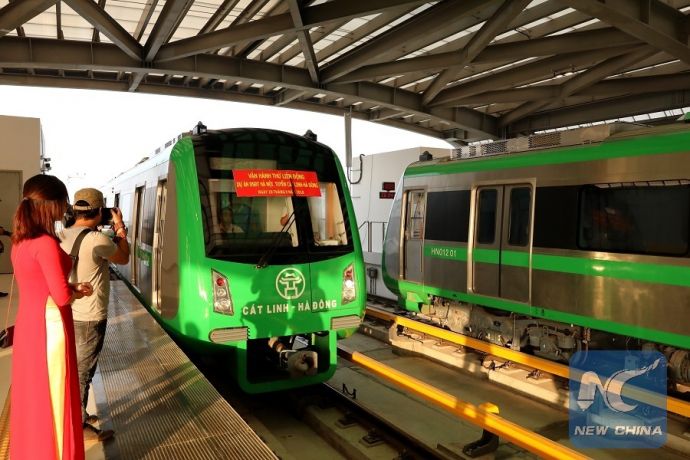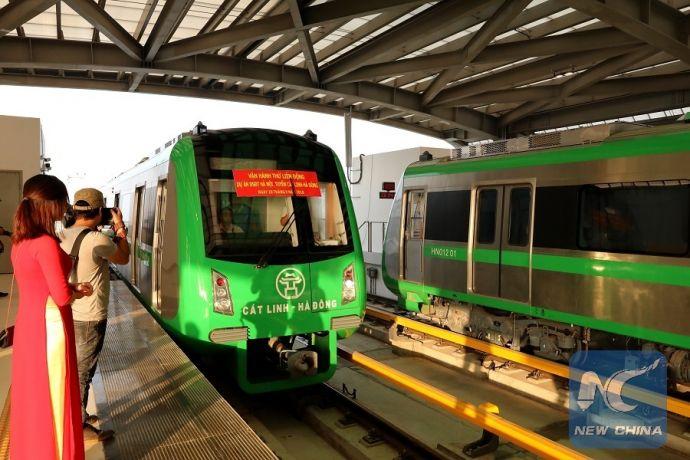
File photo taken on Sept. 20, 2018 shows a scene of trial operation of Vietnam's first urban railwayin Hanoi, Vietnam. (Xinhua/Wang Di)
HANOI, Nov. 30 (Xinhua) -- An elevated train was crossing quietly and rapidly over the first multi-layer intersection in Vietnam's Hanoi capital, while down below a plethora of vehicles were running at a snail's pace in a hot autumn day full of ear-popping sounds, a mixture of motorbike exhausts and horns, and ambulance sirens.
For many foreign visitors to Hanoi in particular and Vietnam in general, even for some local residents, crossing roads or enduring traffic congestions or jams during rush hour almost everyday is a real challenge.
"Buses here are often overcrowded; many young riders usually over-speed or cross the red light; and there are almost no lanes designated for cyclists or pedestrians," a Thai visitor named Natthamon told Xinhua in late November, smilingly joking, "You should buy travel insurance before going around Hanoi."
For most of Hanoians, traveling in the capital city is not so costly or dangerous, but rather inconvenient.
"I ride my motorbike all the year round and have yet to face any traffic accidents over the past 10 years, although according to official statistics, everyday Vietnam faces around 50 traffic accidents which kill over 20 people. What I hate most about traffic here is the frequent occurrence of congestions and jams," local journalist Nguyen Thu Huong said, noting that it takes her 45-60 minutes to cover 10 km between her house and her office.
By mid-2017, Hanoi, with a population of nearly 7.7 million, had some five million motorbikes and 500,000 cars, according to the municipal Transport Department. The city has decided to ban all motorbikes from running in its urban districts from 2030.
Vu Hong Truong, chairman of the Hanoi Railway One Member Limited Company, stated that developing urban railway system in Hanoi is an urgent issue because the city is encountering serious traffic congestion and environmental pollution.
Truong said Hanoi's first urban railway, Cat Linh-Ha Dong elevated rail line constructed by China Railway Sixth Group Co. Ltd. using Chinese ODA and Vietnamese reciprocal capital, is completing final steps such as auxiliary equipment like elevators and decoration before kicking off commercial operation.
There will be 13 trains, including 12 in operation and one in standby, running through 12 stations in a total distance of 13 kilometers in 3 districts, Sun Dezhi, deputy general manager of the overseas branch of China Railway 6th Group, told Xinhua.
Each train, which has four carriages with a total length of 79 meters, can carry up to 1,000 passengers. It will take passengers around 30 minutes to complete the whole journey, fairly rapid compared to other means of transport because they go on their own way.
"A train's maximum speed is 80 kilometers per hour, and its average speed is 35 kilometers per hour. In the short term, trains will depart for every 6 minutes. After that, the interval will be only 2 minutes and 30 seconds," Sun said.
The Chinese company uses on-stream welding technology to ensure high speed, noise and vibration reduction, and anti-derailment, and the signal system is CBTC (Communication-Based Train Control).
"CBTC is the most modern technology in the world. This system helps shorten intervals between trains' departure. The train has an automatic control system which controls its speed," Sun said.
The Cat Linh-Ha Dong elevated railway project officially started construction in October 2011. The trial run of the railway officially began in September 2018.
"There are about 200 Chinese employees on site in Vietnam, and around 1,500 Chinese employees provide back-office support in China," Sun said, adding that hundreds of Vietnamese technicians have been trained in either Vietnam or China to operate the railway system.
"This new means of transport in Vietnam will carry a large number of passengers quickly and conveniently," Nguyen Ngoc Dong, Vietnamese deputy minister of transport, told reporters in late September when he partook in checking and supervising the rail line's trial operation.
During a test run of Cat Linh-Ha Dong rail line, many Vietnamese people were invited to board trains, and all of them expressed their satisfaction with the new means of transport in Hanoi.
"Using this air-conditioned train, we do not have to suffer from traffic accidents, congestions, jams, smoke, dust, heat in summer or coldness in winter, while it runs quickly and quietly," Tran Nhat Duat, a 73-year-old former staff of the Hanoi Transport Department, told Xinhua.
Many other Vietnamese people, both old and young, males and females, shared similar views.
"You see, my sister and I are standing without clutching steel holders to pose for photos on this running train, but we do not lean forward or backward at all. That means the train is running very smoothly," Vu Hien, a young office clerk of South Korean-invested SB Tech Vina Company, told Xinhua.
Standing shoulder-to-shoulder to Hien was her younger sister, Vu Nga, who works as a consultant for overseas studying in Japan. "This Cat Linh-Ha Dong rail route is not along the way we go to work everyday. We hope that more routes like this will be built," she said.
Vietnamese transport officials are considering similar plans to facilitate travel of local working people and visitors. "We should develop at least three urban rail lines and more bus routes to link its urban transport systems in the coming time," Dong said.
"In my opinion, this elevated railway project helps not only ease transport pressure in Hanoi, but also promote the traditional friendship and win-win cooperation between China and Vietnam. It is a symbol of the interface between China's Belt and Road Initiative and Vietnam's 'Two Corridors and One Circle' plan," Sun stated.




 A single purchase
A single purchase







